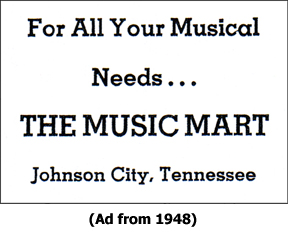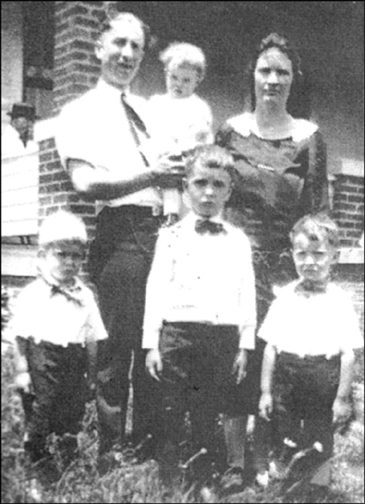Three individuals, Gary Phillips, Dan Ward and Chris White, former Music Mart employees, shared memories of working at the Frick’s store once located on S. Roan Street.

Gary Phillips wrote first: “Bob, you might remember me as the kid who took over your Johnson City Press-Chronicle paper route around 1961 that included Lakeview Drive and surrounding streets.
“The summer after I graduated from Science Hill, I got a job working with the Fricks, repairing, cleaning and overhauling band instruments. I didn’t play any of them and had never been in a band, but Mr. Frick taught me what I needed to know to do the job.
“I started out making $.90 an hour and over four years worked my way up to $2 an hour. Those were great years working for the Fricks and, like you, I could tell many an anecdote on them. They were great folks to work for. I was there when they moved into the store next to their original store and worked there for probably a year or more.
“My in-laws currently live in south Johnson City off Roan Street and occasionally I’ll drive thru downtown on my way to their house. I miss seeing The Music Mart when I pass by there. So many great memories took place there.”
Dan Ward added his comments: “Bob, in the fall of 1964, Gary Phillips called me and he asked me if I would be interested in applying for a part-time job at The Music Mart. Gary had started working there as a janitor, but Mr. Frick had promoted him to instrument repairman.
“I told Gary that I was interested in the part-time job but that I did not think that I would be qualified for a job at a music store because I did not play an instrument or read music. Gary told me to go ahead and apply for the job. Mr. Frick hired me and gave me Gary’s former job.
“Henry and Mary Lou Frick were wonderful people to work with. They were hard workers, but they were very caring and compassionate. I performed various tasks over the next four years at The Music Mart, doing whatever needed to be done.
“I worked at the store in the afternoons after my classes at ETSU, all day on Saturday and full time during the summer. My salary from working there paid for my college education. After graduation from ETSU in June 1968, I continued working there until September 1968 when I went on active duty in the United States Army. The Fricks gave me a tape recorder when I went into service.”
Finally, Chris White offered his remembrances:“Bob, your (Music Mart) columns resonated with me so powerfully and emotionally; it was very surreal. I too am a prodigal son of Mr. and Mrs. Henry Bond Frick. I worked part-time for the Frick's the entirety of my junior and senior high school years as well as my college years.
“Mr. Frick was one of the most witty individuals I've ever met. The dryness in which he delivered his wittiness made him even funnier. He and I used to laugh together until literally tears formed in our eyes. With my young ‘green behind the ears’ naivety, Henry used to have a lot of fun with me, all in good spirit and humor. Each year he would ask Mrs. Frick: ‘Mummy,’ what day is Easter on this year? It was on Sunday last year.’ The man was hysterical.
“I too, dressed and undressed the show window countless times with each seasonal theme. I also put thousands of miles on a vacuum cleaner in that store, as well as swept tons of waste off the sidewalks.
“Then there is Mrs. Frick. She was a saint, dedicated to Mr. Frick, to her work, to superior customer service and to everyone around her.
“Bob, I can't even begin to scratch the surface of the many wonderful and joyful memories I experienced during my time at “a sweet music store.”




